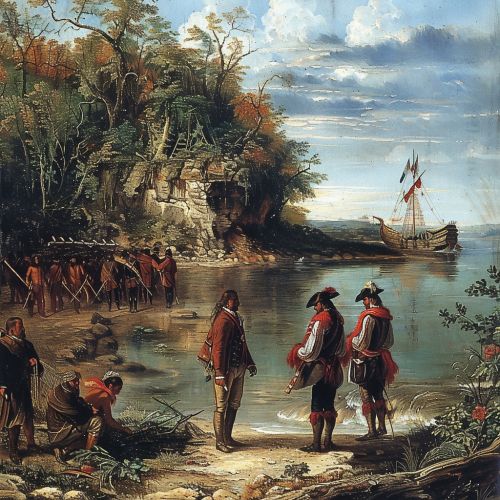French colonization of the Americas
Introduction
The French colonization of the Americas began in the early 16th century and continued until the 18th century, encompassing a vast array of territories in North America, the Caribbean, and South America. This period of colonization was characterized by exploration, settlement, trade, and conflict, as the French sought to expand their influence and control over the New World. The French established several key colonies, including New France, Louisiana, and various Caribbean islands, which played significant roles in the economic and cultural development of the Americas.
Early Exploration and Claims
The initial French exploration of the Americas was driven by the search for new trade routes and resources. In 1524, the Italian explorer Giovanni da Verrazzano sailed along the eastern coast of North America under the French flag, claiming the land for France. This expedition was followed by Jacques Cartier's voyages in 1534, 1535, and 1541, which led to the discovery of the St. Lawrence River and the establishment of the first French settlements in what would become New France.


New France
Establishment and Expansion
New France, the largest and most significant of the French colonies in North America, was formally established in 1608 with the founding of Quebec City by Samuel de Champlain. The colony expanded rapidly, with settlers establishing new towns and trading posts along the St. Lawrence River, the Great Lakes, and the Mississippi River. The French engaged in the fur trade with indigenous peoples, forming alliances with various tribes, including the Huron and the Algonquin.
Administration and Society
New France was governed by a centralized administration under the control of the French crown. The colony was divided into several districts, each overseen by a governor and an intendant. The seigneurial system was implemented, granting large tracts of land to seigneurs, who in turn leased the land to habitants (farmers). The Catholic Church played a significant role in the colony, with missionaries such as the Jesuits working to convert indigenous peoples to Christianity.
Conflicts and Decline
The expansion of New France brought the French into conflict with other European powers, particularly the British and the Dutch. The Beaver Wars (1640-1701) saw the French and their indigenous allies fighting against the Iroquois Confederacy, who were allied with the British and the Dutch. The Seven Years' War (1756-1763) ultimately led to the decline of New France, with the British capturing Quebec City in 1759 and Montreal in 1760. The Treaty of Paris (1763) formally ended the war, ceding control of New France to the British.
Louisiana
Exploration and Settlement
The French exploration of the Mississippi River and the Gulf of Mexico region began in the late 17th century, with explorers such as René-Robert Cavelier, Sieur de La Salle claiming the territory for France in 1682. The colony of Louisiana was established in 1699, with the founding of Biloxi by Pierre Le Moyne d'Iberville. The French established several key settlements, including New Orleans in 1718, which became the colony's capital and a major port.
Economy and Society
Louisiana's economy was based on agriculture, with plantations producing crops such as tobacco, indigo, and sugarcane. The colony relied heavily on enslaved Africans for labor, leading to a diverse and complex society. The French also engaged in trade with indigenous peoples, forming alliances with tribes such as the Choctaw and the Natchez.
Conflicts and Transfer
Louisiana faced numerous challenges, including conflicts with indigenous peoples and rival European powers. The colony was ceded to Spain in 1762 as part of the Treaty of Fontainebleau, but was later returned to France in 1800 under the Treaty of San Ildefonso. In 1803, France sold Louisiana to the United States in the Louisiana Purchase, marking the end of French colonial rule in the region.
The Caribbean
Colonies and Economy
The French established several colonies in the Caribbean, including Saint-Domingue (modern-day Haiti), Guadeloupe, and Martinique. These colonies became major centers of sugar production, relying heavily on enslaved labor. Saint-Domingue, in particular, became one of the wealthiest colonies in the Americas, producing vast quantities of sugar, coffee, and indigo.
Social Structure and Slavery
The social structure of the French Caribbean colonies was highly stratified, with a small elite of white plantation owners (known as grands blancs) at the top, followed by free people of color (known as gens de couleur) and a large population of enslaved Africans. The harsh conditions of slavery led to numerous revolts, including the Haitian Revolution (1791-1804), which ultimately resulted in the independence of Haiti.
Legacy and Impact
The French colonization of the Americas had a profound impact on the regions they controlled, shaping their economic, social, and cultural development. The French introduced new crops, trade networks, and forms of governance, while also leaving a lasting cultural legacy in the form of language, religion, and customs. The interactions between the French and indigenous peoples, as well as the transatlantic slave trade, had significant and lasting consequences for the populations involved.
